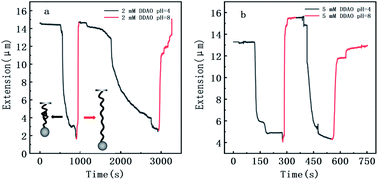Demonstration of pH-controlled DNA–surfactant manipulation for biomolecules
Abstract
The understanding of DNA–surfactant interactions is important for fundamental physical biology and developing biomedical applications. In the present study, we demonstrated a DNA–surfactant nano-machine model by modulating the compaction of DNA in dodecyldimethylamine oxide (DDAO) solutions. By controlling DDAO concentration and pH of solution, we are able to adjust the compacting force of DNA so as to pull biomolecular subunits connected to it. The pulling force of the machine depends on DDAO concentration and pH of solution, ranging from near zero to about 4.6 pN for 10 mM DDAO concentration at pH = 4. The response time of the machine is about 3 minutes for contracting and 2 minutes for releasing in 5 mM DDAO solution. We found that DDAO has no significant influence on DNA under basic conditions, but compacts DNA under acidic conditions, which is enhanced with decreasing pH of solution. Meanwhile, we found the accompanying charge inversion of DNA in the process of DNA compaction by DDAO.



 Please wait while we load your content...
Please wait while we load your content...